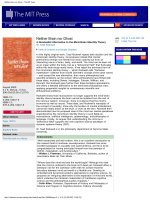the mit press political economics explaining economic policy 2000
Bạn đang xem bản rút gọn của tài liệu. Xem và tải ngay bản đầy đủ của tài liệu tại đây (2.27 MB, 554 trang )
Persson Persson-FM May 22, 2000 14:17
Political Economics
I
Persson Persson-FM May 22, 2000 14:17
Zeuthen Lecture Book Series
Karl Gunnar Persson, editor
Modeling Bounded Rationality
Ariel Rubinstein
Forecasting Non-stationary Economic Time Series
Michael P. Clements and David F. Hendry
Political Economics: Explaining Economic Policy
Torsten Persson and Guido Tabellini
II
Persson Persson-FM May 22, 2000 14:17
Political Economics
Explaining Economic Policy
Torsten Persson and Guido Tabellini
The MIT Press
Cambridge, Massachusetts
London, England
III
Persson Persson-FM May 22, 2000 14:17
c
2000 Massachusetts Institute of Technology
All rights reserved. No part of this book may be reproduced in any form by any electronic or mechanical means
(including photocopying, recording, or information storage and retrieval) without permission in writing from the
publisher.
This book was set in Times Roman by Interactive Composition Corporation.
Printed and bound in the United States of America.
Library of Congress Cataloging-in-Publication Data
Persson, Torsten.
Political economics : explaining economic policy / Torsten Persson and Guido Tabellini.
p. cm. — (Zeuthen lecture book series)
Includes bibliographical references and index.
ISBN 0-262-16195-8 (hc)
1. Economic policy. I. Tabellini, Guido Enrico, 1956– II. Title. III. Series.
HD87.P468 2000 00-028245
338.9—dc21
IV
Persson Persson-FM May 22, 2000 14:17
To Christina, Johanna, Jenny, and Julia
To Giovanna, Marco, and Anna
V
Persson Persson-FM May 22, 2000 14:17
VI
Persson Persson-FM May 22, 2000 14:17
Contents
Series Foreword xiii
Foreword xv
Preface xvii
1 General Introduction 1
1.1 Economic Policy 6
1.2 Politics 10
1.3 Concluding Remarks 14
I TOOLS OF POLITICAL ECONOMICS 15
2 Preferences and Institutions 19
2.1 A General Policy Problem 19
2.2 Restricting Preferences 21
2.3 Restricting Institutions 28
2.4 Discussion 40
2.5 Notes on the Literature 41
2.6 Problems 41
3 Electoral Competition 47
3.1 A Simple Model of Public Finance 48
3.2 Downsian Electoral Competition 49
3.3 Median-Voter Equilibria 51
3.4 Probabilistic Voting 52
3.5 Lobbying 58
3.6 Discussion 62
3.7 Notes on the Literature 63
3.8 Problems 64
4 Agency 69
4.1 Efficient Electoral Competition 70
4.2 Inefficient Electoral Competition 71
4.3 Enforceability, Verifiability, and Observability 73
4.4 Electoral Accountability 77
4.5 Career Concerns 81
4.6 Discussion 87
4.7 Notes on the Literature 89
4.8 Problems 91
VII
Persson Persson-FM May 22, 2000 14:17
viii Contents
5 Partisan Politicians 97
5.1 Policy Convergence 97
5.2 Policy Divergence 99
5.3 Endogenous Candidates 101
5.4 Legislative Bargaining 104
5.5 Discussion 108
5.6 Notes on the Literature 109
5.7 Problems 110
II REDISTRIBUTIVE POLITICS 115
6 General-Interest Politics 117
6.1 General Transfers 118
6.2 Pensions 123
6.3 Regional Transfers 132
6.4 Unemployment Insurance 140
6.5 Discussion 149
6.6 Notes on the Literature 151
6.7 Problems 154
7 Special-Interest Politics 159
7.1 A Model of Local Public Goods 161
7.2 Legislative Bargaining 164
7.3 Lobbying 171
7.4 Electoral Competition 175
7.5 Interactions 180
7.6 Discussion 191
7.7 Notes on the Literature 192
7.8 Problems 195
III COMPARATIVE POLITICS 201
8 Electoral Rules and Electoral Competition 205
8.1 The Economic Model 206
8.2 The Politics of Electoral Competition 207
8.3 Single-District (Proportional) Elections 210
8.4 Multiple-District (Majoritarian) Elections 212
Persson Persson-FM May 22, 2000 14:17
Contents ix
8.5 Broad versus Targeted Redistribution 215
8.6 Discussion 218
8.7 Notes on the Literature 220
8.8 Problems 221
9 Institutions and Accountability 225
9.1 Electoral Rules and Career Concerns 226
9.2 Electoral Rules and Accountability 234
9.3 Separation of Powers 239
9.4 Notes on the Literature 245
9.5 Problems 246
10 Political Regimes 251
10.1 Policy Choices in a Simple Legislature 253
10.2 Presidential-Congressional Regimes 259
10.3 Parliamentary Regimes 262
10.4 Discussion 266
10.5 Notes on the Literature 268
10.6 Problems 269
IV DYNAMIC POLITICS 275
11 Dynamic Policy Problems 277
11.1 Analyzing Dynamic Policy Games 278
11.2 Examples 286
11.3 Discussion 298
11.4 Notes on the Literature 299
11.5 Problems 300
12 Capital Taxation 305
12.1 A Simple Model of Dynamic Taxation 306
12.2 Credibility 307
12.3 Politics 317
12.4 Tax Competition 325
12.5 Discussion 336
12.6 Notes on the Literature 338
12.7 Problems 339
Persson Persson-FM May 22, 2000 14:17
x Contents
13 Public Debt 345
13.1 A Simple Model of Public Debt 346
13.2 The Dynamic Common-Pool Problem 348
13.3 Political Instability 351
13.4 Delayed Stabilizations 361
13.5 Debt and Intergenerational Politics 364
13.6 Discussion 366
13.7 Notes on the Literature 367
13.8 Problems 369
14 Growth 373
14.1 Income Inequality and Growth 374
14.2 Political Instability and Growth 377
14.3 Special Interests, Rents, and Growth 379
14.4 Other Political Determinants of Growth 384
14.5 Discussion 385
14.6 Notes on the Literature 386
14.7 Problems 387
V MONETARY POLITICS 393
15 Credibility of Monetary Policy 397
15.1 A Simple Model of Monetary Policy 397
15.2 Ex Ante Optimality 399
15.3 Credibility 401
15.4 Reputation 405
15.5 Dynamics 408
15.6 Notes on the Literature 412
15.7 Problems 414
16 Electoral Cycles 419
16.1 Career Concerns and Political Business Cycles 420
16.2 Partisan Cycles 426
16.3 Notes on the Literature 430
16.4 Problems 431
17 Institutions and Incentives 435
17.1 Simple Rules and Escape Clauses 436
17.2 Central Bank Independence 441
Persson Persson-FM May 22, 2000 14:17
Contents xi
17.3 Inflation Targets and Contracts 445
17.4 Notes on the Literature 452
17.5 Problems 453
18 International Policy Coordination 459
18.1 A Simple Two-Country Model 460
18.2 Incentives 462
18.3 Institutions 467
18.4 Discussion 473
18.5 Notes on the Literature 474
18.6 Problems 475
19 What Next? 479
19.1 Some Positive Questions 479
19.2 Analytical Issues 483
19.3 Concluding Remarks 488
References 489
Author Index 515
Subject Index 521
Persson Persson-FM May 22, 2000 14:17
XII
Persson Persson-FM May 22, 2000 14:17
Series Foreword
The Zeuthen Lectures offer a forum for leading scholars to develop and synthesize novel
results in theoretical and applied economics. They aim to present advances in knowledge in
a form accessible to a wide audience of economists and advanced students of economics.
The choice of topics will range from abstract theorizing to economic history. Regardless
of the topic, the emphasis in the lecture series will be on originality and relevance. The
Zeuthen Lectures are organized by the Institute of Economics, University of Copenhagen.
The lecture series is named after Frederik Zeuthen, a former professor at the Institute of
Economics.
Karl Gunnar Persson
XIII
Persson Persson-FM May 22, 2000 14:17
XIV
Persson Persson-FM May 22, 2000 14:17
Foreword
Political economics has become one of the most active research areas in the last decades.
Building on earlier work of the public choice school, rational expectations macroeconomics,
and game theory, political economics has taken the next step by including rational voters,
parties, and politicians in the models. In political economics, rational agents populate the
markets and participate in politics. The assumption of rational behavior allows an adequate
description of complicated incentives and trade-offs, and has contributed to a substantial
increase in the understanding of the finer workings of the economic system. Similarly, taking
the incentives of politicians into account allows a better understanding of the formation of
policy and the role of different political institutions in shaping economic policy.
An authoritative survey of this body of research is long overdue. A survey should draw the
big lines, compare and evaluate the different contributions, and point toward new directions
for research. It should be an exposition that simplifies, cuts to the bone, and renders the
basic structure of the arguments visible to the reader. The present book does this. It goes
even further, as new ideas are developed and explored.
But books are finite in length, and authors inevitably have to make selections of which
areas to cover. The focus here is on democratic societies and on important economic prob-
lems where the viewpoint of political economics seems particularly apt. The uninitiated
reader will enjoy the first section of the book, where the basic issues and tools of modeling
political equilibria are discussed. Armed with Condorcet winners, median voter theorems,
Downsian and partisan parties, and so forth, the reader is ready for the subsequent parts.
Part 2 is devoted to redistributive politics. This is an important area where the traditional
assumption of a benevolent planner seems most at odds with reality. The focus is on how
the interplay between democratic institutions and self-seeking individuals, lobby groups,
and parties determines the degree of redistribution. In the background is the possibility of
explaining the huge cross-country differences in redistributive policies.
In part 3 the focus is on comparative politics. Can we explain differences in fiscal policies
by alluding to differences in democratic institutions? For instance, will a European-style
parliamentary system provide different outcomes than an American-style presidential sys-
tem? What are the consequences of different electoral systems? Is there a rationale for the
separation of powers?
Part 4 discusses intertemporal issues: debt, pensions, capital taxation, and growth. When
policy takes place over time, new strategic dimensions arise and expectations are important.
Present governments can influence the alternatives available for future governments. This
may explain excessive public debt levels. The interplay between inequality and growth has
been the subject of long debates. A possible link is provided by the redistributive policies
chosen by the median voter and their effect on savings. The final part of the book is devoted
to the topical area of monetary policy institutions.
XV
Persson Persson-FM May 22, 2000 14:17
xvi Foreword
The authors have made an impressive effort in providing a unified framework for large
parts of the exposition. This makes the book particularly appealing; it makes assessments
of different contributions much easier. Furthermore, the arguments have been made as
simple and transparent as possible. Torsten Persson and Guido Tabellini are masters in
“economizing on the modeling.” They have another virtue: an eminent ability to maintain
perspective and relate to the important issues. The text never wanders off into inessential
technical details.
This book will become the standard reference for researchers in the area and the backbone
of graduate courses around the world—certainly in Copenhagen.
Christian Schultz
Institute of Economics
University of Copenhagen
Persson Persson-FM May 22, 2000 14:17
Preface
This book iswrittenfor the professionaleconomist or political scientistwho wants to become
familiar with the recent research on political economics. We especially target students taking
graduate courses in economics or political science, but some of the material could also be
used in advanced undergraduate courses. Although the book is self-contained and most
concepts and methods are developed gradually, the reader should have a good background
in microeconomics, macroeconomics, and applied game theory.
Part 1 of the book introduces the analytical tools and is a prerequisite for the remainder of
the book. Parts 2 to 5 deal with substantive economic policy issues; each of these can be read
independently. Each part begins with a separate introduction, where we highlight a number
of empirical regularities, put the following chapters in context, and provide a detailed road
map. We comment on the original literature both as we go along and in separate “Notes
on the Literature” at the end of each chapter. All chapters (except the first and the last)
include a number of problems, constructed by Isabelle Brocas, Micael Castanheira, Ronny
Razin, and David Str¨omberg. These problems have educational value for the student, but
they also extend some of the results and ideas in the text. A separate exercise book by the
same authors (published by MIT Press and made available electronically) reproduces the
problems and suggests solutions.
The project leading up to this book has developed gradually. We were gaining a per-
spective on this body of research, while writing a number of surveys, for the Handbook
of International Economics, Vol. 3 (Persson and Tabellini 1995), the Handbook of Macro-
economics, Vol. 2 (Persson and Tabellini 1999a), and the Handbook of Public Economics,
Vol. 3 (Persson and Tabellini 1998). We are grateful to North-Holland and the editors of
those volumes for letting us use some of the ideas in these surveys, and conversely—since
the last of those Handbooks is still forthcoming—to MIT Press for letting us use some of
the material in this book.
A final impetus for writing the book was the invitation to deliver the Zeuthen Lectures
at the University of Copenhagen in June 1998. We are deeply grateful to the organizer of
those lectures, Karl-Gunnar Persson, for his stimulus and warm hospitality during our two-
week stay. More generally, we would like to thank the economics faculty at the University of
Copenhagen for their comments and criticism at a crucial stage of the project. Without those
comments, that friendly working environment, and the subsequent deadline, the project
would have dragged on much longer.
When the book was almost completed, we had the opportunity to present its detailed
contents, in July 1999, at “Encounters with Authors,” organized by the Center for Basic
Research in the Social Sciences at Harvard University. We are grateful to Jim Alt, who
organized the event, and to all participants inthis ten-session workshop for listeningcarefully
to our arguments, reading the book in draft form, and sharing their thoughts and comments
XVII
Persson Persson-FM May 22, 2000 14:17
xviii Preface
with us. That feedback came right when we needed it most and was an essential input in
improving the quality of the final product.
The material underlying the book was used in various courses and lectures that we gave
separately or together in the recent past: the Seventh Summer School in Economic Theory at
the Hebrew University, Harvard University, the Kiel Institute for World Economic Studies,
the London School of Economics, the NAKE Lectures in the Netherlands and, naturally,
at our home institutions, Stockholm University and Bocconi University. We are grateful to
students in those classes for their comments and their help in spotting mistakes or clearing
up confusion.
Some of the material in the book draws on our joint published work with G´erard Roland.
We are deeply grateful to him for his collaboration and for the inspiration he provided while
we were working together. Many of the ideas appearing in chapters 9 and 10 owe much to
his involvement in those joint projects.
We want to express our thanks to many colleagues for their comments and feedback.
These were invaluable in gaining a better understanding of the subject matter, finding better
ways of organizing the presentation, and improving the exposition. Our greatest debt is to
the authors of the companion exercise book. Isabelle, Micael, Ronny, and David read the
entire book carefully and helped us to improve the exposition and correct mistakes.
We are grateful for comments on single chapters or the whole book by Jim Alt, Carlos
Boix, Francesco Daveri, Francesco Giavazzi, Giovanni Favara, Paul Klein, Assar Lindbeck,
Eric Magar, Michele Polo, G´erard Roland, Ken Shepsle, and Fabrizio Zilibotti. We would
also like to thank a number of people for useful discussions, guidance to the literature, and
specific comments on the Handbook chapters, in particular Alberto Alesina, Alan Auerbach,
David Austen-Smith, David Baron, Roel Beetsma, Tim Besley, Francesco Daveri, Daniel
Diermeier, Mathias Dewatripont, Avinash Dixit, Barry Eichengreen, Jon Faust, Raquel
Fernandez, Fabio Ghironi, Rex Ghosh, Elhanan Helpman, Dale Henderson, Peter Kenen,
Jean-Jacques Laffont, Francesco Lippi, Roger Myerson, Maury Obstfeld, Per
Pettersson, Adam Posen, Ken Rogoff, G´erard Roland, Howard Rosenthal, Andrei Shleifer,
Lars Svensson, John Taylor, Jean Tirole, and Gisela Waisman.
At different stages of the project, we benefited from excellent research assistance by
Fabio Ghironi, Paolo Dudine, and Alessandra Bonfiglioli.
Writing a book is a long and tiring process. It was made considerably easier by the
outstanding administrative and editorial assistance we received from Christina L¨onnblad
and Alessandra Startari through many revisions. Christina made a truly heroic effort in the
last month of work, checking language and references and editing and assembling the final
version of a long and complicated manuscript, while managing to remain her usual cheerful
self.
Persson Persson-FM May 22, 2000 14:17
Preface xix
Last but not least, we want to thank our editor, Terry Vaughn, for being so kind and
accommodating to our requests and helping us put an end to this enterprise.
Finally, we are grateful to a number of institutions for giving us financial support. During
the course of the project, our research was supported by the Axel and Margaret Ax:son
Johnson Foundation, the Bank of Sweden Tercentenary Foundation, Bocconi University,
the Centro Nazionale Ricerche, the London School of Economics, Harvard University, and
the Swedish Council for Research in the Humanities and Social Sciences, and by a TMR
grant from the European Commission.
Persson Persson-FM May 22, 2000 14:17
XX
Persson Book May 22, 2000 14:19
1General Introduction
Economic policies vary greatly across time and place. In the late 1990s total government
spending as a fraction of gross domestic product stood at more than 60% in Sweden and well
above 50% in many countries of continental Europe, but around 35% in Japan, Switzerland,
and the United States. Striking variations are also evident in the composition of spending:
transfers are high in Europe, but low in Latin America. Among the fifteen members of
the European Union, spending on the unemployed ranged from 2% to 17% of total public
spending, whereas the replacement rate in unemployment insurance ranged from 20% to
90%. At the same time, public debt was less than 40% of GDP in Norway but more than
120% in Italy and Belgium. Inflation has taken a different time path over the last thirty years
in many industrialized countries, resulting in an average inflation rate of roughly 8% in the
United Kingdom but 3% in Germany. Available measures of corruption vary a lot, even
across countries with comparable levels of development and similar economic structure.
Despite these differences, we observe some common patterns. Virtually all industrial
countries saw the growth of government take off in the mid-1930s and again in the late 1960s,
whereas it slowed down, or turned negative, after the war and toward the late 1980s. Public
pensions have grown rapidly in the last three decades to become a dominant component of
public spending in all European countries. During the same period, public investment has
been hovering around 3% of GDP. Inflation accelerated everywhere in the developed world
in the 1970s and came down again in the 1990s, though earlier in some countries than in
others.
How can we explain the variations in the data? And what are the sources of the common
patterns? Do these outcomes covary systematically with other aspects of economic policy
or with the economic and social environment? Can alternative political constitutions and
legislative procedures explain part of the policy outcomes? Are the observed patterns of
spending and taxation likely to reflect socially optimal policies—given some normative
criterion? Do they even reflect the preferences of a majority? If not, how can we account for
the deviations? Are they reflections of political failures due to imperfections in the political
process?
Goals
This book explores how such questions might be answered. We want to explain economic
policy in modern democracies: what determines the size and form of redistributive programs,
the extent and type of public goods provision, the burden of taxation across alternative tax
bases, the size of government deficits, the extent of corruption by public officials, the
structure of labor market regulation, the stance of monetary policy during the course of
the business cycle or the electoral cycle? When searching for an answer to these questions,
we reach the boundary between political science and economics. As in political science,
1
Persson Book May 22, 2000 14:19
2 Chapter 1
we study collective choice and political institutions. We want to understand how policy
decisions are made, what shapes the incentives and constraints of the policymakers taking
those decisions, and how conflicts over policy are resolved. But as in economics, we are
ultimately interested in the outcomes of policy decisions. We also want to understand how
the economic consequences of policy feed back into private agents’ policy preferences and
how these preferences are aggregated back into public policy.
It is popular to refer to research in this area as “political economy.” Sometimes that term
is used to suggest an alternative analytical approach, as if the traditional tools of analysis in
economics were not appropriate to study political phenomena. This is definitely not our view
and not our approach in this book. On the contrary, we borrow the main tools of analysis
from economics, modeling policy choices as the equilibrium outcome of a well-specified
strategic interaction among rational individuals. Hence, the title of the book.
Roots
Alt and Chrystal published a book with a similar title more than fifteen years ago (1983).
Since then, research in political economics has expanded rapidly; it now transcends several
traditional fields. The roots of this research can be traced back to at least three different
traditions in economics and political science.
The most recent tradition, from which we come as economists, is the theory of macroeco-
nomic policy, dating back to the work by Lucas in the mid-1970s. Lucas taught us to study
the consequences of economic policy by contrasting systematic policy rules. Only when
policy is formulated as a rule can we give precise content to private expectations, through
the assumption of rational expectations. As suggested by Kydland and Prescott (1977) and
Calvo (1978), however, not all policy rules are equally plausible. Only those rules that the
policymaker has no incentive to abandon become credible, or “time-consistent.” This idea
gave rational expectations a game-theoretic foundation. Rational individuals reason strate-
gically and base their expectations on their perception of the policymaker’s incentives. A
complete theory must thus include specific hypotheses about what governs those incentives.
From this insight it is only a short step to a political approach to macroeconomic policy.
Since that step was taken in the mid-1980s, a rapidly growing literature on macroeconomic
policy has attempted to build more solid foundations for the hypotheses on the policymak-
ers’ incentives. Because of its starting point, research in this tradition has always insisted
on solid underpinnings in economic theory and maintained the assumption of individual
rationality. It has also paid particular attention to intertemporal policy choices and economic
dynamics. At the same time, however, this research has often relied on rather superficial
assumptions about political institutions and political conflict and tended to shy away from
empirical, applied analysis. Early contributions to this tradition were surveyed in Persson
and Tabellini 1990.
Persson Book May 22, 2000 14:19
General Introduction 3
A second, older and more established tradition in the positive analysis of economic pol-
icy is public choice, which goes back to the classic contributions by Buchanan and Tullock
(1962) and Olson (1965). This school has focused on public finance, trade policy, and reg-
ulatory policy. Moreover, the agency problem between the government and citizens at large
has always held center stage in this line of research. The public choice school emphasized
many ideas that are still highly relevant in today’s research on economic policymaking. One
of these is the crucial importance of interest groups, especially the importance of lobbying
by organized interest groups and the pervasiveness of rent-seeking activities. Another long-
lasting contribution is the idea that many agency problems in politics originate in the public’s
being imperfectly informed about the details of specific policy programs. The public choice
school also stressed the importance of the constitution and the constraints it imposes. Re-
searchers in this tradition were reluctant, however, to use formal game-theoretic tools or to
impose strong notions of individual rationality. As a result, the initial work sometimes relied
on weaker theoretical or microeconomic foundations. The voluminous literature on early
public choice is surveyed in several places and with particular clarity and completeness by
Frey (1983) and Mueller (1989).
A third fundamental tradition for research on political economics is the formal analysis in
political science. This tradition goes back to works such as Riker 1962 and is often referred
to as rational choice. Results in the spatial theory of voting and axiomatic social choice
theory, following the publication of Arrow’s (1951) impossibility theorem, disillusioned
many researchers about the prospects for a general theory of collective choice based on
individual preferences alone. Since the early 1980s, however, formally oriented political
science has changed its emphasis, turning to the study of collective choice within specific
political institutions. This approach models the institutional details, exploiting the tools of
noncooperative game theory. For example, alternative political systems differ in the way
politicians are elected, how agenda-setting powers are allocated, and how the legislative
process is structured. Such differences can be formally represented by alternative extensive
form games. Researchers in the rational choice tradition have mainly focused on political
institutions as such, paying little attention to specific economic policy issues. Ordeshook
(1986) and Inman (1987) survey some of the early literature, whereas some of the contri-
butions in Mueller 1997 contain more up-to-date surveys.
Ten to fifteen years ago, these three traditions largely developed in parallel without too
much contact with each other. Integration among the three has been increasing over time,
however. In this book, we try to combine the best of all three traditions.
As in the macroeconomic tradition, we take a general equilibrium approach. With only
a few exceptions, the models we analyze have explicit microfoundations. Economic be-
havior as well as political behavior are thus derived from the same individual preferences.
Given equilibrium policies, economic behavior is aggregated into economic outcomes in
Persson Book May 22, 2000 14:19
4 Chapter 1
well-specified markets. Given equilibrium economic outcomes, political behavior is aggre-
gated into policy decisions under well-specified political institutions. In an overall equilib-
rium, economic and political outcomes are mutually consistent.
As in the public choice tradition, we stress the ability of interest groups to influence the
political process. We also highlight the agency problems in politics, namely the conflict
between political representatives acting in their own interest but against that of voters at
large. Furthermore, constitutional issues play an important role throughout the book.
As in the rational choice tradition, we pay close attention to the structure of collec-
tive decision making, modeling specific institutional features as well-defined delegation
games. We also borrow a number of specific ideas and tools of analysis from this tradition,
particularly in our modeling of electoral competition and legislative decision making.
In simplified form, our approach can thus be summarized as follows: we adopt the
equilibrium approach of the macroeconomic theory of policy and exploit the tools of rational
choice in analyzing some of the classic problems in public choice.
Positive versus Normative Analysis
The book always conceives economic policy as the equilibrium outcome of a well-defined
noncooperative game under primitive assumptions about economic and political behavior.
The rules of that game reflect the nature of the political institutions. We thus take these
institutions as given and see them as important determinants of economic policy (though
institutions are certainly not the only determinants of policy in these models). But we refrain
from seeking positive explanations for the structure of these institutions. Nor do we seek to
explain how political institutions have evolved over time. Implicitly, we view institutions as
inherited by history and difficult to change. To some extent, this is really our view: political
institutions have a great deal of inertia, and when institutional change takes place, it is
often in the midst of dramatic social events or profound and radical changes in society. To
understand the evolution of institutions, pure and abstract analysis should thus be integrated
with a historical approach. Such a positive analysis of how institutions evolved is certainly
an interesting area of research. But we are also trying to simplify our task, and it is easier
to study one problem at a time.
The book asks positive questions about policy: we primarily want to know why policy
is the way it is, not what it ought to be. Nevertheless, in many instances we contrast the
positive predictions against a normative benchmark. Without much discussion, and in the
absence of clearly superior alternatives, our normative benchmark throughout the book is
a Benthamite utilitarian optimum, namely the policy maximizing the sum of individual
utilities. If the analysis has normative implications, these typically concern the design
of institutions, such as the structure of budgetary procedures, the degree of central bank









